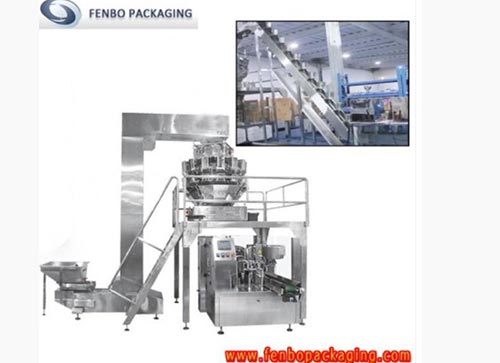How does an automatic sealing machine work?
Aug 19,2024 | Views: 275
An automatic sealing machine is designed to close and seal containers, such as bags, bottles, pouches, or boxes, automatically. These machines are essential in various industries like food and beverage, pharmaceuticals, cosmetics, and packaging. Here’s how an automatic sealing machine typically works:
2. Sealing Mechanism: This can vary depending on the type of sealing required (e.g., heat sealing, pressure sealing, induction sealing). The mechanism applies the necessary force, heat, or other methods to create a seal.
3. Control System: Manages the timing, pressure, temperature, and speed of the sealing process to ensure consistent and reliable seals.
4. Heating Elements (for heat sealing machines): Generate the heat required to melt and bond the sealing material, such as plastic or foil.
5. Cooling System: Cools the sealed area immediately after sealing to solidify and strengthen the bond.
6. Sensors and Detectors: Ensure proper alignment and positioning of the containers before sealing. Some machines also include sensors to detect defects in the sealing material or to verify the integrity of the seal.
2. Sealing Process:
Heat Sealing: For machines that use heat sealing, the sealing mechanism, often a pair of heated jaws, applies pressure and heat to the edges of the container (e.g., plastic bags). The heat melts the sealing material, and the pressure bonds it together. Once sealed, the cooling system solidifies the seal.
Induction Sealing: In induction sealing, a foil liner is placed inside the cap of the container. The container passes under an induction coil, which creates an electromagnetic field. This field heats the foil, causing it to bond with the container’s rim, creating a hermetic seal.
Pressure Sealing: For containers like boxes, pressure sealing machines use mechanical pressure to apply adhesive tapes or other sealing materials to close the container.
3. Post-Sealing Operation: After sealing, the conveyor moves the sealed containers to the next stage, such as labeling, packing, or shipping.
4. Quality Control (optional): Some machines are equipped with quality control systems that check the integrity of the seal and remove any containers that do not meet the required standards.
Induction Sealers: Use electromagnetic induction to seal foil liners to the rims of containers, common in the food and pharmaceutical industries.
Vacuum Sealers: Remove air from the container before sealing, often used for preserving food.
Next: Which Pouch Filling and Sealing Machine is Right for You?
Key Components of an Automatic Sealing Machine:
1. Conveyor System: Transports the containers to the sealing station and moves the sealed containers to the next stage of production.2. Sealing Mechanism: This can vary depending on the type of sealing required (e.g., heat sealing, pressure sealing, induction sealing). The mechanism applies the necessary force, heat, or other methods to create a seal.
3. Control System: Manages the timing, pressure, temperature, and speed of the sealing process to ensure consistent and reliable seals.
4. Heating Elements (for heat sealing machines): Generate the heat required to melt and bond the sealing material, such as plastic or foil.
5. Cooling System: Cools the sealed area immediately after sealing to solidify and strengthen the bond.
6. Sensors and Detectors: Ensure proper alignment and positioning of the containers before sealing. Some machines also include sensors to detect defects in the sealing material or to verify the integrity of the seal.
Basic Operating Steps:
1. Container Positioning: The containers are placed on the conveyor and transported to the sealing station. Sensors or a timing mechanism ensure accurate positioning under the sealing heads or mechanism.2. Sealing Process:
Heat Sealing: For machines that use heat sealing, the sealing mechanism, often a pair of heated jaws, applies pressure and heat to the edges of the container (e.g., plastic bags). The heat melts the sealing material, and the pressure bonds it together. Once sealed, the cooling system solidifies the seal.
Induction Sealing: In induction sealing, a foil liner is placed inside the cap of the container. The container passes under an induction coil, which creates an electromagnetic field. This field heats the foil, causing it to bond with the container’s rim, creating a hermetic seal.
Pressure Sealing: For containers like boxes, pressure sealing machines use mechanical pressure to apply adhesive tapes or other sealing materials to close the container.
3. Post-Sealing Operation: After sealing, the conveyor moves the sealed containers to the next stage, such as labeling, packing, or shipping.
4. Quality Control (optional): Some machines are equipped with quality control systems that check the integrity of the seal and remove any containers that do not meet the required standards.
5. Cleaning and Maintenance: Regular cleaning and maintenance are required to ensure the machine’s longevity and reliability, especially in food and pharmaceutical applications.
Types of Automatic Sealing Machines:
Band Sealers: Use a continuous belt to move containers through a set of heated jaws, ideal for sealing bags or pouches.Induction Sealers: Use electromagnetic induction to seal foil liners to the rims of containers, common in the food and pharmaceutical industries.
Vacuum Sealers: Remove air from the container before sealing, often used for preserving food.
L-Bar Sealers: Cut and seal plastic film around a product in one motion, typically used for shrink wrapping.





